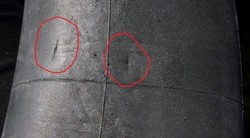steverob
Guru
- Location
- Buckinghamshire
Are you really sure you've not picked up another deflation-causer after those 30 miles?
First of all, these are not 'pinch flats'. You get these when your tyre is running too low a pressure - and you have yours at 100psi - or hit a pothole really hard, normally combination of the two.
This sounds like either your tyre or the rim tape is causing the puncture. When you remove the punctured tube, you must be able to find the puncture hole. That will show you where to look on the tyre/rim.
Must pre-inflate the inner gently before inserting.
I'll admit I'm making an assumption they are pinch flats based on what I know, which isn't exactly very much, but I'll explain what I do know and you can tell me if you think my assumptions are right or wrong.
Every time I have got a puncture before where it was caused by a thorn/glass/other debris, the way I've noticed has been the same - the repetitive "thud" noises while riding as the wheel turns, so then you get off the bike and notice the tyre already half deflated and eventually completely deflated anywhere between 10 secs and 10 minutes later depending on the size of the hole. Whereas the "bang fssssh" complete instant deflation is something I have only ever experienced twice before this current run of bad luck, and each time it was either on the same day as, or the ride after changing a tube from a "regular" puncture, which combined with the little round holes in the tube, has always led me to the assumption that these were caused by pinch flats.
As I may have said before elsewhere, I enjoy riding bikes, but I don't care much for fixing them (not just bikes, that goes for most things to be honest), so I've never really been all that bothered about learning more than doing the very basics, which is why I may have misdiagnosed this completely (or possibly diagnosed it correctly but it turns out it's completely my fault for not doing it right!).
When I get home (although given it'll be pitch black by then and there's not much light in our garage, I may have to wait until the weekend) I'll check to see if I still have the failed inner tubes and should be able to work out if the puncture marks were all in the same place. I know I still have one tube lying around, hopefully I didn't throw the others.

